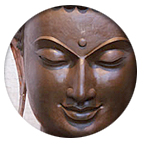 Our minds are very distracted; our senses constantly pull in multiple directions—every sound, every sight, every scent triggers thoughts and emotions, creating movement and confusion. Only when things are still can the dust settle and the mind’s eye see clearly. Stillness Meditation is linked to serenity; the practices are designed to still an active mind, ultimately enabling it to be present in the moment.
Our minds are very distracted; our senses constantly pull in multiple directions—every sound, every sight, every scent triggers thoughts and emotions, creating movement and confusion. Only when things are still can the dust settle and the mind’s eye see clearly. Stillness Meditation is linked to serenity; the practices are designed to still an active mind, ultimately enabling it to be present in the moment.
 Rinpoche describes the meaning and value of Stillness Meditation, also known as Shamatha Meditation.
Rinpoche describes the meaning and value of Stillness Meditation, also known as Shamatha Meditation. Rinpoche explains the three types of Shamatha Meditation.
Rinpoche explains the three types of Shamatha Meditation.Silent Meditation
By closing down the portion of our minds dedicated to speech—even if we are still engaged in internal dialog—our minds are freer, and we are better able to see more about ourselves. Silent Meditation is the most basic of practices—though to be successful, it requires advanced concentration skills which may take some time to develop. In essence, we sit in a quiet environment, and, clearing our minds of all thoughts, focus on the breath entering and leaving our bodies. When we feel our minds drift, we simply bring them back to our breath. Practiced consistently, this meditation helps us stay present in daily life.
Concentration Meditation
While physical stillness is relatively easy to achieve, mental stillness is far more of a challenge. Our minds are used to having something to cling to. Usually that thought is random; we jump from topic to topic depending on external influences. Concentration Meditation changes that, by providing a single topic on which we focus for a long period. As we advance, the topic becomes increasingly narrow—and our focus becomes increasingly deep.
Centering Meditation
Centering Meditation helps us become more grounded in the here and now. We are not thinking about the past or worrying about the future; we are simply aware of where we are at this moment in both time and space. The process helps us release painful emotions and negative thought patterns. It is particularly useful at the end of any normal stressful day, and can be helpful when recovering from a traumatic experience.
Quieting the Mind
When we are silent, our minds still may be full of worry and doubt—even if it is only about how well we are meditating. In Quieting the Mind we remove all the distractions of doubt. We practice unhooking from them, detaching for a short period. This proves useful in daily life, too. Quieting the Mind works in concert with concentration. Because it is very difficult to stop thoughts by force, we use concentration to guide them instead.
Contemplative Arts
The contemplative arts provide a single point of concentration that enables us to calm and clear our minds, while also bringing beauty to our environments. Calligraphy and painting, photography and flower arranging, archery and dance, even equestrian dressage are practices that help focus the mind and build awareness while celebrating the senses.

LIVE BETTER
Life is complex, puzzling and often painful.
Sometimes it seems there must be a better way
to manage—and there is. It is as simple as looking
at a problem through a different lens.



